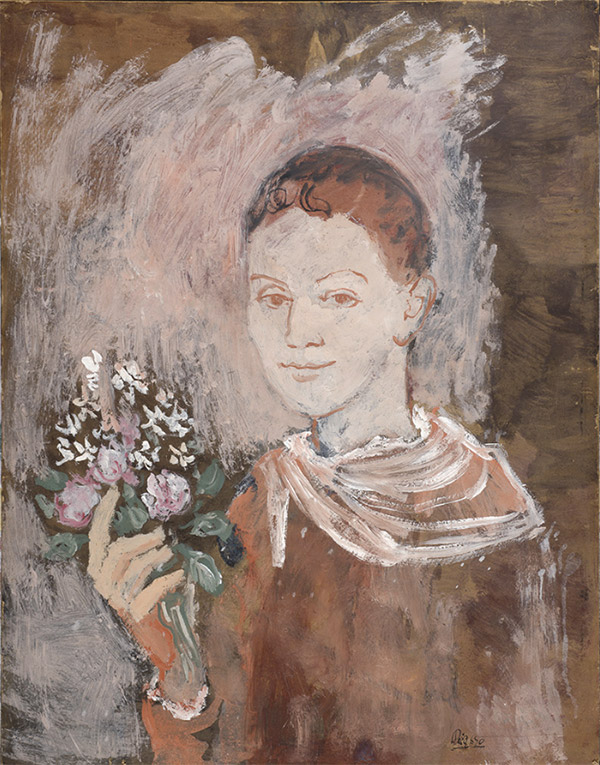Picasso collectors across the Atlantic
Dudensing’s concern about the salability of Picasso’s work in late 1928 was unfounded; the artist already had a small collector base in New York. At that time, amongst Dudensing’s clientele a handful owned Picassos that they had purchased from other sources. Mary Hoyt Wiborg (whose sister Sara Murphy was a close friend of Picasso’s) had recently bought The Lovers, 1923 (Z.V,14) and Grand nature morte, 1922 (Z.V,228) in Paris.[i] Chester Dale, a stockbroker whose collection was guided by his wife, Maud, a painter and art scholar, owned The Mother, 1901 (Z.XXI,291) and Juggler with Still Life, 1905 (Z.I,294), both also acquired in Europe.[ii] On the other hand, Lillie P. Bliss, one of the founders of the Museum of Modern Art, bought her Picassos in New York: Green Still Life, 1914 (Z.IIb,485) at the 1922 auction of the Kelekian Collection and Woman in White, 1923 (Z.V,1) at Kraushaar Galleries.[iii]
Another Valentine Gallery client, A. E. Gallatin, held what was arguably the most important collection of Picasso’s work. An artist from a wealthy family and the founder of the Gallery of Living Art, Gallatin spent time with Picasso in the spring of 1927 and acquired works directly from the artist. The Gallery showcased Gallatin’s collection in ground floor rooms at New York University and is considered the country’s first public collection of contemporary art. When it opened in the fall of 1927, the Gallery of Living Art featured four Picassos from Gallatin’s collection dating from 1913 to 1919; the following year he added Pipe and Violin, 1914 (Z.IIb,475).[iv]
One of the Valentine Gallery’s first clients, T. Catesby Jones, owned a Picasso pastel, Guitar and Fruit Bowl, c. 1924-25, acquired from Galerie Jeanne Bucher in Paris in 1925.[v] Jones began collecting art while in Paris during the previous summer and became friendly with Bucher who guided his collection over the years. On December 5, 1928, Jones’s purchase of the Rose period gouache, Woman with Kerchief, from the Valentine Gallery represented Dudensing’s first Picasso sale. Apparently this sale was the catalyst he needed to begin handling the artist’s work. On that day he wrote to Matisse: “Incidentally should you see any late Picasso abstract—you remember the show 1926—on that order—say #20 or #25 [standard French canvas sizes, approximately 30 x 25 inches]—let me know.”[vi] He was referring to the Galerie Paul Rosenberg exhibition in Paris in June 1926, the dealer’s largest showing of Picasso’s paintings most of which were from 1923-25. Matisse’s response to Dudensing’s missive is unknown but the Valentine Gallery sales records indicate that Dudensing sold six Picassos in 1929 and seven in 1930.[vii] During these two years before leaving to open his own gallery, Matisse helped build a solid foundation for Dudensing’s reputation as an important source for Picassos in New York.
[i] Wiborg sold The Lovers through the Valentine Gallery to Chester Dale in February 1938. The painting is now in the National Gallery of Art (1963.10.192).
[ii] Dale’s Picasso collection increased significantly during the summer of 1930 when, in Paris, he acquired five paintings dated between 1903 and 1923 on the eve of the release of Maud’s monograph on the artist. In 1939, Dudensing orchestrated the sale of The Mother from Dale to the Saint Louis Art Museum (10:1939).
[iii] Both paintings are now in museum collections: Museum of Modern Art (92.1934) and Metropolitan Museum of art (53.140.4).
[iv] The Gallery’s inaugural exhibition in December 1927 actually included five works by Picasso, the four from Gallatin’s collection: Z.IIb,516; Z.III,386; Z.IIb,389; and possibly Z.IIb,460, and an unidentified loan from Wildenstein Galleries. Elisabeth L. Cary, “Gallery of Living Art and American Print Makers,” New York Times (December 18, 1927), 12 X.
[v] Purchase information for the pastel was confirmed in an email from J’Laine Newcombe, Registrar at the Virginia Museum of Fine Arts, May 13, 2016. By 1939, Jones owned six additional Picassos: a 1907 Landscape (Z.IIa,41); two Cubist paintings: Guitar and Glasses, 1912 (Z.IIa,359) and Still Life, 1914 (DR 744); and three abstract works on paper from the 1920s.
[vi] Letter from Valentine Dudensing to Pierre Matisse, December 5, 1928, Pierre Matisse Gallery Archives, MA5020, Box 89, Folder 29, Department of Literary and Historical Manuscripts, The Morgan Library & Museum, New York, N.Y.
[vii] Valentine Dudensing Ledger Books, vol. II: January 1926-February 1931. The Museum of Modern Art Archives, New York.





 índice
índice